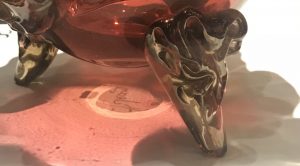For this assignment I examined the red vase with Japanese decoration c. 1880 made by the French artist Jean Auguste. The vase is 6 1/16 x 7 1/8 in. and made of red glass with applied amber glass, gold and enamel. It seems like the red vase was blown by hand first. The artist may have started with a glass tube, similar to the ones we s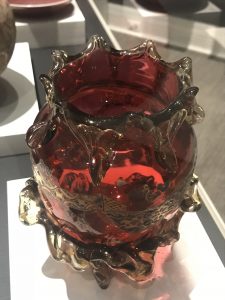 aw in the chemistry lab. He would have blown the glass and formed it to close at the base whilst remain op
aw in the chemistry lab. He would have blown the glass and formed it to close at the base whilst remain op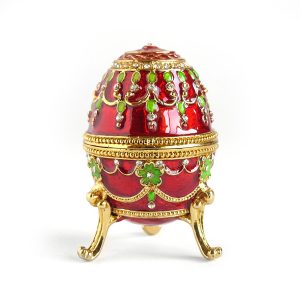 en at the top. The vase is narrower around the base and gets increasingly wider until it curves back in at the top and flares out just slightly at the opening. It is shaped sort of like an egg, expect for the top lip and opening, it almost reminds me of a Faberge egg because of the shape, the intricate design and the stand made of gold glass which resembles the same stand used to hold Faberge eggs.
en at the top. The vase is narrower around the base and gets increasingly wider until it curves back in at the top and flares out just slightly at the opening. It is shaped sort of like an egg, expect for the top lip and opening, it almost reminds me of a Faberge egg because of the shape, the intricate design and the stand made of gold glass which resembles the same stand used to hold Faberge eggs.
It seems like the vase could have been used to hold flowers, but I believe the vase likely functioned as a decorative object, not intended to hold anything. Next I believe the artist applied the decorative design to the outside of the vase. The design looks like a two-sided ribbons twirling around the vase, this ribbon 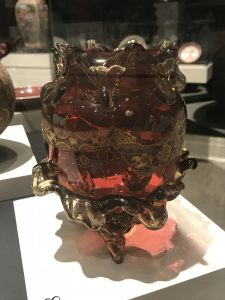 emulates the quality of movement and liquidity, which is present in the adoring gold glass that I will address next. The ribbon folds and shows an ornate flower design on one side and gold circles in rows on the other side. The flower design is painted in purple, blue and gold enamel. The design incorporates flowers and geometric designs. There are also smaller flower abstractions around the twirling ribbon. The designs are mostly opaque, but the red light still shines through them, which creates a beautiful warm effect. The ribbon is somewhat centered and runs around the widest part of the vase. The ribbon ends with a detailed golden tail.
emulates the quality of movement and liquidity, which is present in the adoring gold glass that I will address next. The ribbon folds and shows an ornate flower design on one side and gold circles in rows on the other side. The flower design is painted in purple, blue and gold enamel. The design incorporates flowers and geometric designs. There are also smaller flower abstractions around the twirling ribbon. The designs are mostly opaque, but the red light still shines through them, which creates a beautiful warm effect. The ribbon is somewhat centered and runs around the widest part of the vase. The ribbon ends with a detailed golden tail.
The gold glass used to adorn and hold the vase looks like dripping honey. The artist heated the glass and pulled it to create beautiful organic forms. The gold glass encompasses the lower forth of the vase and twists and melts around the base. It also acts as a seat for the vase and three short legs protrude from the golden glass. The legs are short and remind me of the feet of an old fashioned bathtub. I believe the legs were added later as they have a visible seem separating them from the gold around the base. The legs are covered in twisting organic forms of golden glass. The entire golden glass seat and legs are one piece and the vase sits inside and is affixed to the golden glass. The shiny quality and apparent look of flexibility evokes images of Louise Bourgeois’ Arch of Hysteria. The soft and 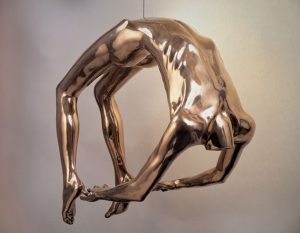 curving lines of this vase looks much like that of a human being, I believe Jean August was appreciative of Japanese art, yet at the same time trying to exoticize their culture with the bright reds and golds and contradictory supple and flat forms.
curving lines of this vase looks much like that of a human being, I believe Jean August was appreciative of Japanese art, yet at the same time trying to exoticize their culture with the bright reds and golds and contradictory supple and flat forms.
The golden glass is also used on the top forth of the vase adorning the opening. The golden glass forms 8 pointed triangles around the circumference of the opening. The glass points are formed by two triangles on either side of them, It looks like the artist created two triangles along the edge of the opening and turned the vase upside-down to allow the honey like glass to drip down into a point. More likely the artist heated the glass and pulled it into points using tongs. The golden glass along the top circumference resembles icicles along a roofline. In the center bottom of the 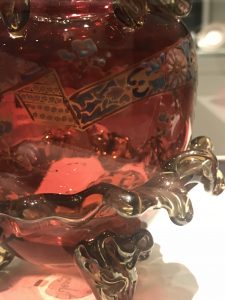 vase I believe Auguste engraved his name, you can see something that looks like a signature in the shadow below the vase.
vase I believe Auguste engraved his name, you can see something that looks like a signature in the shadow below the vase.
I believe the artist’s purpose was to explore the dichotomy that glass can create. He highlights the smooth middle section of the vase with the delicate painted flowers, which he juxtaposes with the organic forms in the gold glass adornments.
